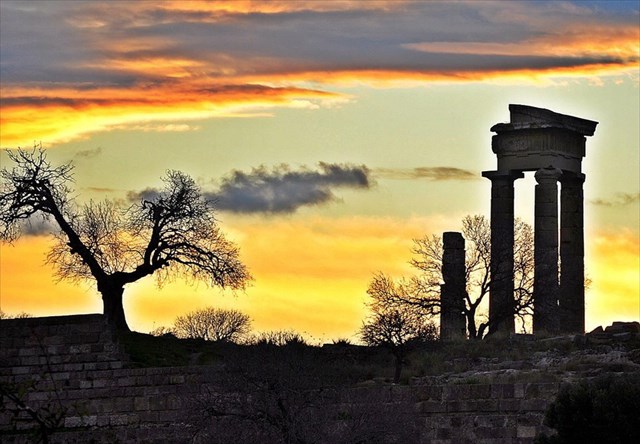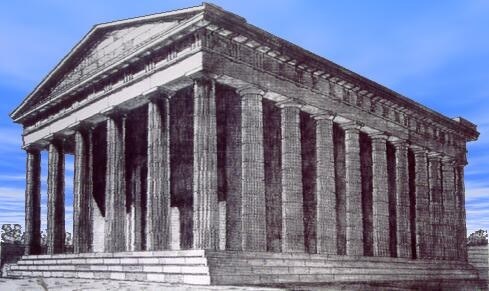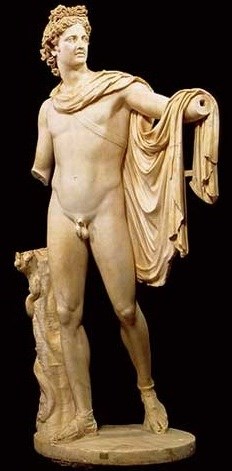An easy mystery cache. You have to read the listing and answer simple questions to find the cache (below). Beware of muggles, please. Enjoy caching!
Eine einfache Rätsel-Cache. Sie müssen einfache Fragen zu beantworten, um den Cache (unten) zu finden. Vorsicht vor Muggels, bitte. Genießen Sie die Zwischenspeicherung!
Μια εύκολη cache μυστήριο. Θα πρέπει να απαντήσει σε απλές ερωτήσεις για να βρείτε το cache (κάτω). Προσέξτε για τους άλλους ανθρώπους. Απολαύστε το!
Snadná mysterka. Pro nalezení keše musíte přečíst listing a odpovědět na jednoduché otázky níže. Prosím pozor na mudly. Užijte si kešování!

The Temple of Apollo stands on the southern part of the hill, on the west side of a large rectangular terrace. It is orientated east-west. The Temple of Apollo was smaller than the Temple of Athena and Zeus which stood on the same Acropolis. Part of the northeast side had been restored with four columns and part of the architrave. The Rhodes Acropolis dominated the western and highest part of the city. It was not fortified like most ancient acropoleis. It consisted of a monumental zone with Sanctuaries, large temples, public buildings and underground cult places. The buildings were built on stepped terraces supported by strong retaining walls. The buildings on the Acropolis date to the Hellenistic and Late Hellenistic periods (3.-2. century BC). From 1946 onwards the Greek Archaeological Service carried out restoration work in the area of the Temple of Apollo, which had suffered considerable damage from bombing in the 2nd World War and from the weight of the artillery that had been installed there.
CACHE:
1. The temples on the Acropolis were built in the A.-B. century BC
2. Nowadays we can see the remains of C large main temples on the Acropolis
3. The Temple of Apollo now has D columns
N 36 26.A(B+C)D
E 28 12.(D+B)DA

 ........ ........
Der Apollo-Tempel steht auf dem südlichen Teil des Hügels, auf der Westseite von einem großen rechteckigen Terrasse. Es ist Ost-West orientiert. Der Tempel des Apollo war kleiner als der Tempel der Athena und Zeus, der auf der gleichen Akropolis stand. Ein Teil der nordöstlichen Seite hatte mit vier Säulen und ein Teil der Architrav restauriert. Die Rhodos Akropolis dominiert den westlichen und höchsten Teil der Stadt. Es wurde nicht wie die meisten alten acropoleis befestigt. Es bestand aus einem monumentalen Zone mit Heiligtümern, große Tempel, öffentliche Gebäude und unterirdische Kultstätten. Die Gebäude wurden durch starke Stützmauern unterstützt Stufenterrassen gebaut. Die Gebäude auf der Akropolis Datum der hellenistischen und Spät hellenistischen Zeit (3.-2. Jh. v. Chr.). Von 1946 an die griechische Archäologische Dienst durchgeführt Restaurierungsarbeiten im Bereich des Tempels von Apollo, die erhebliche Schäden durch Bombenangriffe im 2. Weltkrieg und aus dem Gewicht der Artillerie, die dort installiert worden waren gelitten hatte.
CACHE:
1. Die Tempel auf der Akropolis wurden in der A.-B. gebaut Jahrhundert v. Chr.
2. Heute können wir die Überreste von C großen Haupttempel auf der Akropolis zu sehen
3. Der Apollo-Tempel hat jetzt D Spalten

Ο Ναός του Απόλλωνα βρίσκεται στο νότιο τμήμα του λόφου, στη δυτική πλευρά ενός μεγάλου ορθογώνιου βεράντα. Είναι προσανατολισμό ανατολή-δύση. Ο Ναός του Απόλλωνα ήταν μικρότερο από το ναό της Αθηνάς και του Δία που βρισκόταν στην ίδια την Ακρόπολη. Μέρος της βορειοανατολικής πλευράς είχε αποκατασταθεί με τέσσερις κίονες και τμήμα του επιστυλίου. H ακρόπολη της Pόδου δέσποζε στο δυτικό και ψηλότερο μέρος της πόλης. Δεν είχε οχυρωματικό χαρακτήρα όπως οι παλιές ακροπόλεις. Αποτελούνταν από μια μνημειακή ζώνη με Iερά, μεγάλους ναούς, δημόσια κτίρια και υπόγειους χώρους λατρείας. Τα κτίρια χτίστηκαν στις ενισχυθεί αίθρια που υποστηρίζονται από ισχυρά τείχη αντιστήριξης. Τα κτίρια κατά την ημερομηνία της Ακρόπολης στην ελληνιστική και Ύστερη Ελληνιστική περίοδο (3.-2. Αιώνα π.Χ.). Από το 1946 και μετά, η Ελληνική Αρχαιολογική Υπηρεσία πραγματοποίησε εργασίες αποκατάστασης στην περιοχή του Ναού του Απόλλωνα, το οποίο είχε υποστεί σημαντικές ζημιές από τους βομβαρδισμούς στο 2ο Παγκόσμιο Πόλεμο και από το βάρος του πυροβολικού που είχαν εγκατασταθεί εκεί.
ΚΡΥΠΤΗ:
1. Οι ναοί στην Ακρόπολη χτίστηκαν στην A.-B. αιώνα προ Χριστού
2. Σήμερα μπορούμε να δούμε τα ερείπια των C μεγάλων ναών της Ακρόπολης
3. Ο Ναός του Απόλλωνα τώρα έχει D στήλες
Apollonův chrám stojí na jižní straně kopce, na západní straně velké obdélníkové terasy. Je orientovaný východ-západ. Apollonův chrám byl menší než chrám Athény a Dia, který stával na stejné Akropoli. Část severovýchodní strany byla obnovena se čtyřmi sloupy a částí architrávu. Rhodos Akropolis dominuje západní a nejvyšší části města. Nebyla opevněna, podobně jako většina starých akropolí. Sestávala z monumentální oblasti svatyní, velkých chrámů, veřejných budov a podzemních kultovních míst. Budovy byly postaveny na stupňovitých terasách, které byly podpořeny silnými opěrnými zdmi. Stavby na Akropolis jsou datovány do helénistického a pozdně helénistického období (3.-2. století př. nl). Od roku 1946 řečtí archeologové provádějí restaurátorské práce v oblasti Apollonova chrámu, který utrpěl značné škody při bombardování ve 2. světové válce a také hmotností dělostřelectva, které na něm bylo umístěno.
CACHE:
1. Chrámy na Akropoli byly postaveny ve A.-B. století př.n.l.
2. Dnes na Akropoli můžeme vidět zbytky C hlavních velkých chrámů
3. Chrám Apollonův má dnes D sloupů
|